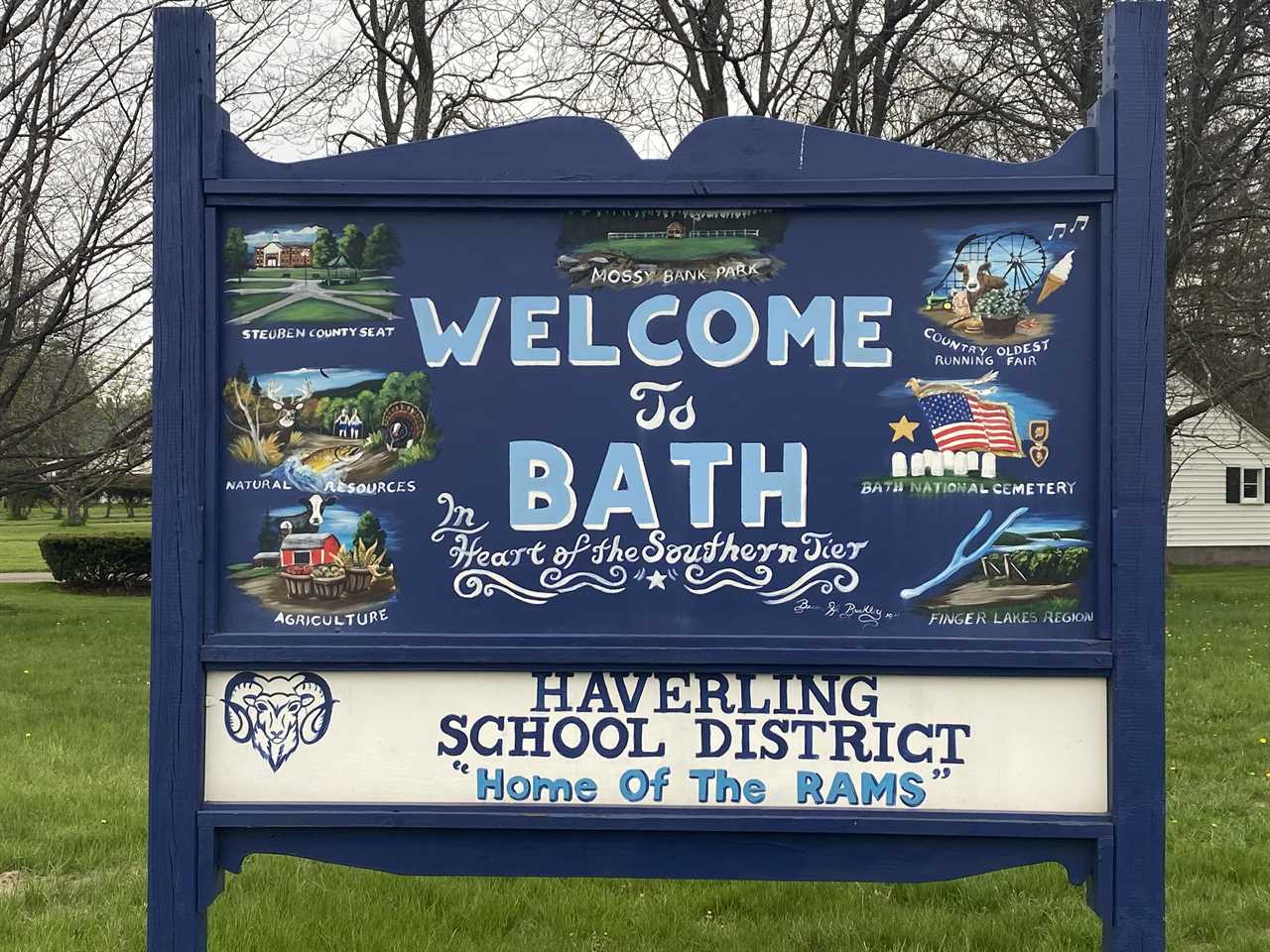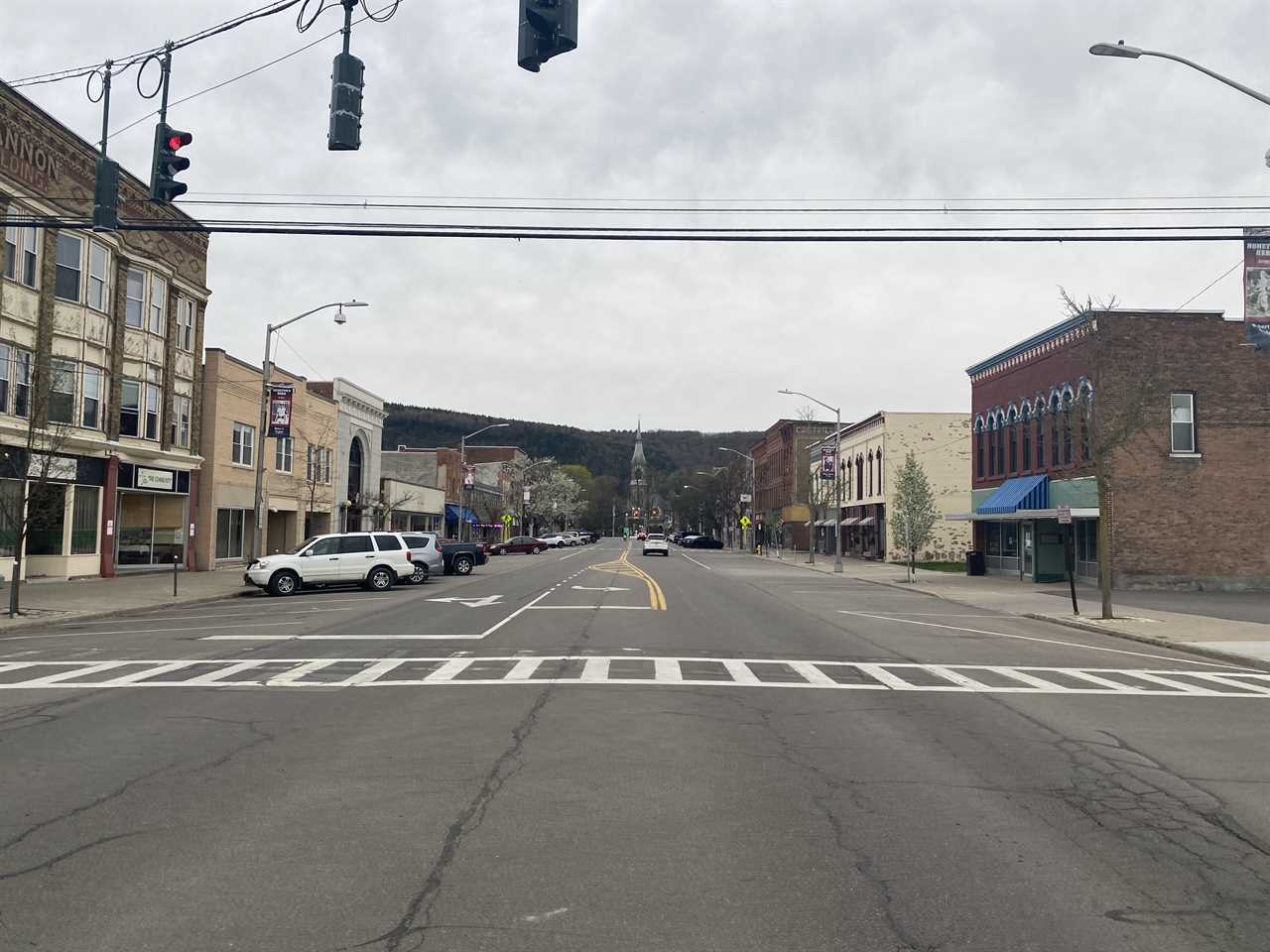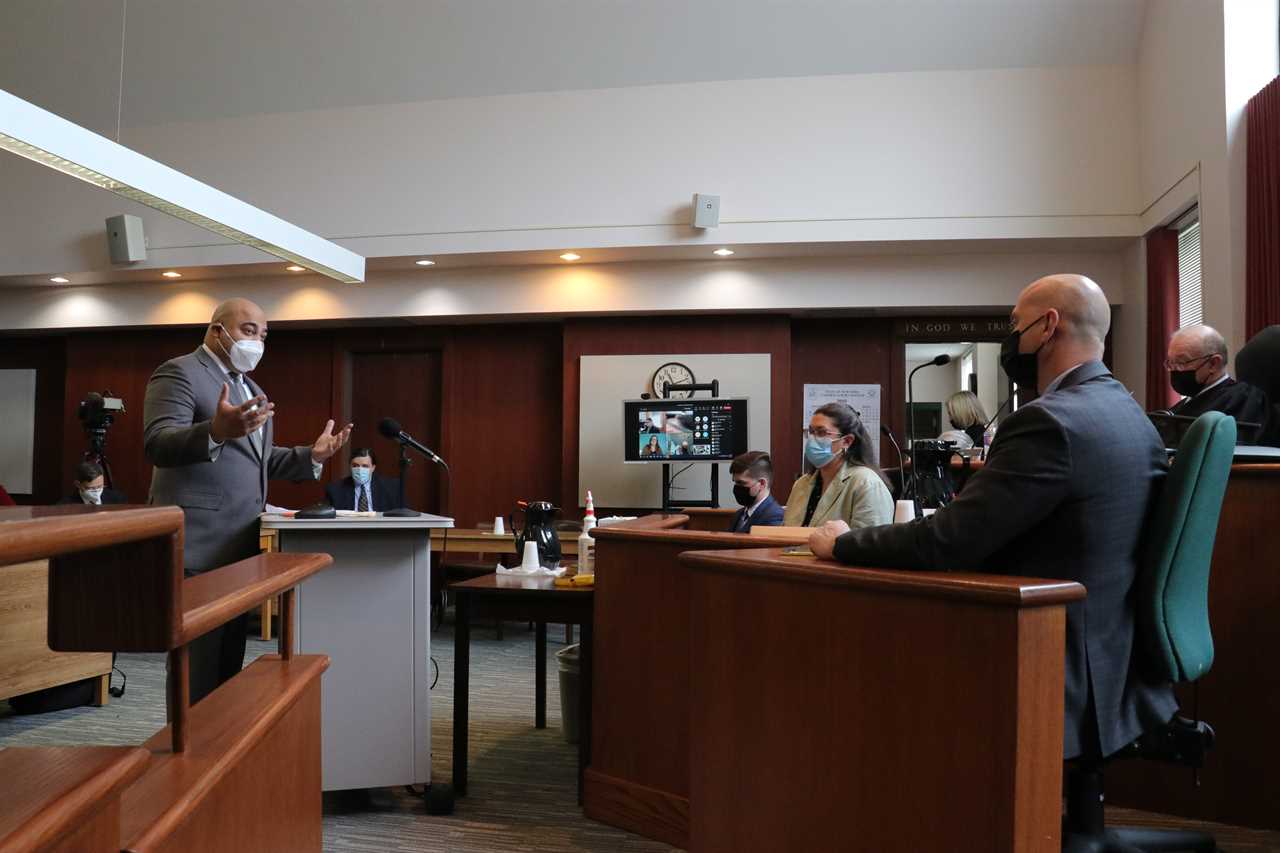
BATH, N.Y. — Bronx Rep. Ritchie Torres last week made a five-hour trek far to a rural upstate town that's poised to decide the fate of New York's congressional delegation — and possibly the balance of power in Congress next year.
“I felt I had to come here personally and make the case for preserving a historically south Bronx congressional district,” Torres (D-N.Y.) said after being given three minutes to address a court.
Visiting Bath about 30 miles from the Pennsylvania border was probably not something Torres expected to do a few months ago. But the Southern Tier community is now the center of New York politics — the place that will determine the state’s district lines for congressional and state Senate seats for the next decade.
The stakes are huge both for New York and Democrats nationally. The fate of lines rests with Steuben County Acting Supreme Court Justice Patrick McAllister, a Republican who was elected to a seven-year term in 2017 to an office that is designed to focus on wills and adoptions.
New York’s new redistricting process run by Democrats has collapsed so spectacularly that a case could be made that McAllister is now the most powerful elected official in the state.
The reason is simple: The GOP filed its lawsuit against the initial lines earlier this year in the small, rural Southern Tier community that is as Republican friendly a county as there is in the blue state.
Now the decision rests in McAllister's court.
“I’ve always believed that there’s a lot to be said for a good old country lawyer and common sense,” state Sen. Tom O'Mara, a Republican who represents the area, said. “And that’s what I believe Judge McAllister is. He’s no highfalutin city lawyer.”
After Republicans won a stunning legal victory challenging congressional and state Senate lines drawn by Democrats, the state’s top court let McAllister set the rules for this year's elections. He has already ordered a new date for the primary, moving it from June 28 to Aug. 23, and he will soon issue rules determining who will be able to get on the ballot.
And most critically, the question of the new maps is now entirely in the hands of him and a special master he chose. He expects to make a decision by May 20.
Various draft lines that have been drawn in recent months would have made Democrats the favorites in anywhere from 17 to 23 of New York’s 26 congressional seats, but that could now change. Democrats hold 19 of the 27 seats now, before one is cut due to the state's slow population growth.
It’s plausible that the decisions being made in Bath could wind up determining which party controls Congress at some point in the next decade. Democrats hold a 12-seat advantage in the House and are projected to lose seats in this year’s mid-term election.
Suddenly, a part of the state that is all too often an afterthought to decision makers has become the place where their futures are being determined.
The shift in power to this little-known corner of New York has also raised concerns. The rushed process means that the hearing Torres attended last week was the only one that will be held on the new lines, guaranteeing that any residents of the state’s population centers unable to make the journey will have no opportunity to make their case in person.
“How that is fair in a state like New York which prides itself on its diversity of opinion, thought and expression is totally unclear to me,” Brooklyn Rep. Hakeem Jeffries (D-N.Y.) said in an interview the night before the hearing.
A new home for redistricting

Upon arriving in downtown Bath last Thursday, a reporter took a picture from the street and, before stepping foot on a sidewalk, was shouted at by resident Cindy Cunningham.
“This town stinks!” she said. “You don’t want any photos.”
Bath, where a 5,000-square-foot Victorian home within walking distance of a two-block retail district near the village green can be bought for $260,000, retains some charm.
“It was always a good, nice place to raise a family,” Town Board Member William Glosick said of the place where golfer Jack Nicklaus’ uncle was the local dentist for 55 years. “A nice rural community. We’ve got a nice park over there … We’re not really a big city; that’s what’s nice.”
But like so many small towns upstate, Bath — the birthplace of the Golden State Killer — faces serious economic and morale crises.
Ever since the Philips light bulb plant shut down a decade ago, the economy doesn’t seem to consist of much beyond the regional VA hospital and the fact that a few nearby places like Corning haven’t been completely abandoned by industry. Nearly every resident who was asked what one should know about their town responded with some variety of “nothing good” — you’re better off in nearby Hammondsport or Painted Post, they said.
Similar towns in battleground states like Ohio and Pennsylvania have taken starring roles in American politics in recent years.
But unlike in the other parts of northern Appalachia, places like Steuben County have had no significant role in driving the discussion in a state where policy discussions usually come down to negotiations between officials from the cities and those from the suburbs.
Even when top officials make their periodic one-hour drop-in visits to the region, they tend to go to places like the small cities of Hornell and Elmira or the wine-making towns a bit further north.
For most decision makers, the majority of the 156 small towns between Jamestown and Binghamton that contain a combined 500,000 residents — places like West Almond and East Otto and Van Etten and Bath — are just funny-sounding places on a map.
But now, the fate of all of New York’s 26 congressional districts and 63 state Senate districts rests in a courthouse downtown.
A changed redistricting process comes to town

This year was the first in which the state followed new rules for redistricting that come from a constitutional amendment that was written as a compromise when ex-Gov. Andrew Cuomo attempted to backtrack on a pledge to veto gerrymandered lines a decade ago.
That amendment created an “Independent Redistricting Commission” tasked with drawing maps. But it left the Legislature with the authority to draw their own lines once they voted down two plans from the commission.
Democrats, who have dominated the state Assembly since Watergate, came out of the 2020 elections with a supermajority in the state Senate for the first time since 1846. That meant they were able to dominate the map-making process for the first time in generations, and the lines they approved in early February left their party well-positioned to pick up a few seats in Congress even as the size of the state’s delegation is poised to shrink from 27 to 26.
Republicans immediately filed suit and strategically picked Steuben County.
“This is the result of forum shopping on the part of the plaintiffs,” Common Cause NY executive director Susan Lerner said after testifying last week. “They knew exactly where they wanted to be. They wanted to be in a remote rural county, and they were successful.”
McAllister ruled in favor of Republicans for two reasons. The new redistricting commission issued only one set of draft maps before ending its work. Since the Legislature never voted down the required second plan, it never obtained the authority to enact it own lines. Additionally, he found the maps ran afoul of a new constitutional mandate that the lines not be drawn to benefit a particular party.
Initially, he left legislators with a chance to pass new maps with some degree of bipartisan support. But in the event this didn’t happen, he also appointed Carnegie Mellon fellow Jonathan Cervas as a special master who would start drawing new lines as a backup plan.
Democrats remained confident that they’d eventually win on appeal. Even if they lost on the gerrymandering decision, which seemed to be less of a long shot than the procedural one, the 2012 amendment guaranteed them a chance to fix the lines.
But the Court of Appeals — where every judge was nominated by a Democratic governor — ruled late last month and handed Democrats losses on both the procedural and technical questions. And due to the commission’s failure, Democrats did not have the authority to make any tweaks, leaving the questions about how to draw new lines and hold elections on a new timetable in McAllister's hands.
Driving to Bath for redistricting

Elizabeth OuYang is as passionate about redistricting as anybody in New York.
“In [the Queens neighborhood of] Richmond Hill, a huge number of Indo-Caribbeans have died of Covid-19,” she said while appearing to fight back tears after delivering testimony last Friday.
“They are currently divided into seven Assembly districts and three state Senate districts. And as a result, because they’re so splintered, they are ignored.”
OuYang, a civil rights attorney, is involved with the group OCA-Asian Pacific American Advocates, and she helped drum up attendance at a hearing of the redistricting commission in Queens last November, where scores of individuals made similar pleas to provide Richmond Hill with districts centered on the community.
Now, her hopes rest entirely with a judge on the other side of the state and a special master who lives in Pittsburgh.
It remains unclear what approach either the judge of special master is thinking of taking. On Friday, McAllister's comments were mostly limited to those involving the procedure of his courtroom, while Cervas was silent.
The location of the lone hearing made it impossible for dozens of interested community members to make their plea in person.
“Public transportation would have taken us 10 hours to get here,” OuYang said. “None of us have cars; we had to rent a car. Three hotel rooms, gas, food, tolls are all part of the expenses for five of us to come up here.”
Jeffries expressed similar concerns in a letter to McAllister last week about the hearing in Bath being the only one that is planned.
The only public transit option to get to the courthouse, he wrote, is a bus. And taking that would require “someone in Brooklyn to leave in the middle of the night, take the subway to Port Authority and depart at 1:30 a.m., only to arrive late to the hearing you have scheduled.”
“We have heard crickets in response,” he said.
Jeffries expressed concerned that the process could be a “kangaroo court” relying on testimony from Republicans. “A process that permits a single hearing in the village of Bath, which is closer to Pittsburgh, Cleveland, and Toronto than it is to New York City is fatally flawed,” he said.
The congressman announced on Monday night that he is making a five-figure digial ad buy attacking the process for "excluding communities of color."
McAllister told the court last week that Cervas “has been provided access to the [redistricting commission’s] records.”
And with the deadline looming to draw maps quickly enough to hold elections this year, that should be sufficient, Republicans argue.
“Most of the testimony you’re going to hear is repetitive with respect to what was held in public hearings with the [redistricting commission],” said former state Sen. George Winner, one of the Republicans who brought the suit and who used to represent the region. “You can have more hearings, but this testimony is redundant.”
Some Democrats have argued that if there’s going to be just one hearing, it would make the most sense to have it somewhere like Manhattan or Albany.
“How would people in Steuben County have felt if they had to go to New York City?” Winner said in response to those arguments.
----------------------------------------
By: Bill Mahoney
Title: The town that will decide New York redistricting for the next decade
Sourced From: www.politico.com/news/2022/05/11/new-york-redistricting-bath-00031096
Published Date: Wed, 11 May 2022 03:30:00 EST






